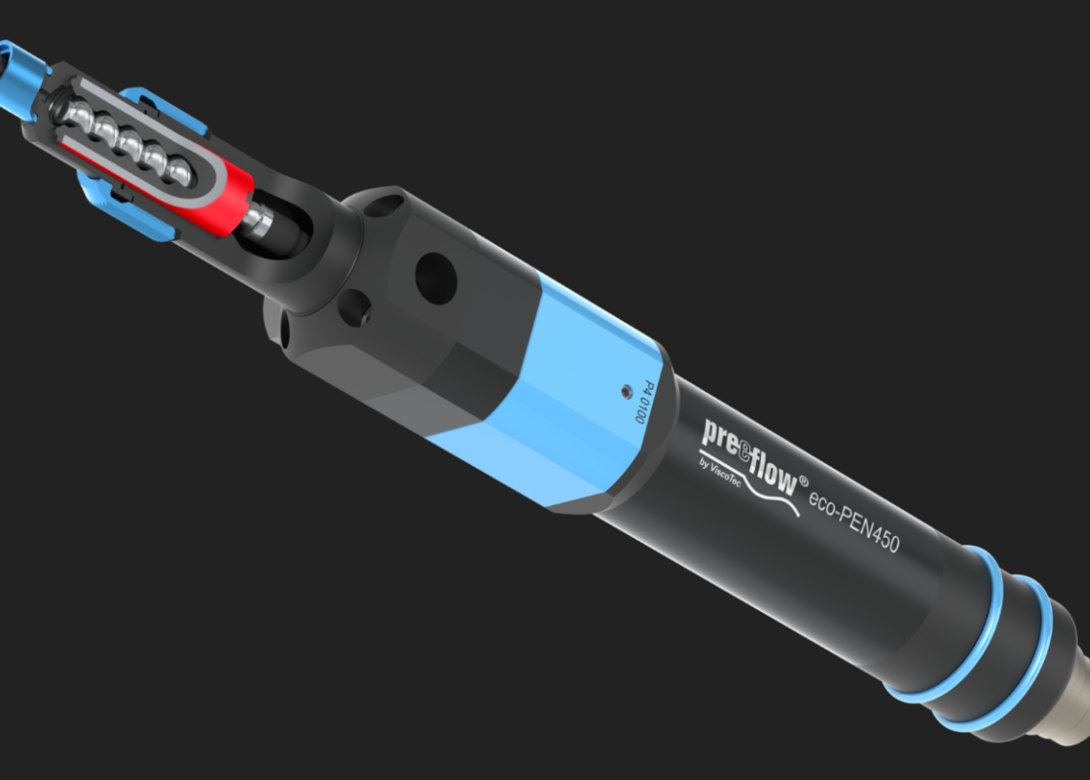
Anaerobic adhesives are the most popular type in industry, used as threadlockers and retaining compounds. Applications for anaerobic adhesives that require more accuracy and precision in dispensing can be challenging because of the unique cure mechanism. Here Peter Swanson, managing director at Intertronics, discusses the use of preeflow dispensers for anaerobic adhesives.
Due to its easy handling and fast curing, anaerobic single component adhesives are popular in a wide variety of bonding applications, most notably locking together threaded parts like nuts and bolts, or joining a bearing onto a shaft. Many of these processes are workshop-based and done by manual application, but there are instances when a more exacting approach is needed; for example in a non-manual automated assembly process, such as automotive magnet bonding or the production of form-in-place sealing gaskets where a profiled 3D bead is required.
Anaerobic adhesives cure under the absence of oxygen and in the presence of metal ions. In these conditions it cures quite quickly which is usually advantageous, but presents a challenge for application equipment. As it is a system for dispensing, it needs to be made of inert material, preferably plastic components. Metal dispense tips or pressure pots pose a contamination problem for anaerobic adhesives, as blockages can occur in plastic hosing of small diameter when left overnight as the anaerobic adhesive may gel.
How can we precisely dispense anaerobic adhesives?
The preeflow eco-PEN is a precision volumetric, positive displacement, dosing/dispensing system that gives the user accuracy and repeatability by means of a rotor, which turns inside a stator. By this progressive cavity pump technology, the eco-PEN doses and dispenses a wide range of material viscosities with no stress to the material; providing absolute control. Numerous long-term tests have been conducted to prove the viability of this technology with anaerobically reactive adhesives.
The eco-PEN housing is metal-free and designed to be in the fluid path. Metallic parts of the rotor assembly that come into contact with the material are specially treated so that curing is not initiated. Initial testing showed that even extremely fast-reacting, high performance adhesives could remain in the dispenser for three days without cure. This means that anaerobic materials can be kept in the dispenser over weekend downtimes, removing the need for time-consuming cleaning sessions.
Dispensing tests with the anaerobic adhesive
Longer-term and more detailed trials tested the eco-PEN for durability and functionality when used with anaerobic adhesives. A total of 14 different adhesives from seven manufacturers were evaluated. After filling the dispenser with the adhesive approximately 3ml, the equivalent to the capacity of the dispenser, was dispensed and the system was depressurised. The adhesives remained in the eco-PEN for up to 32 days without being dispensed, and the start-up behaviour then checked by means of a dispenser torque measurement. Even after 32 days standing time, a good dispensing result was achieved with most of the subject adhesives.
Result of the long-term tests
More than half of the adhesives showed no change after staying dormant in the dispenser over the full test period. With three of the adhesives, a cleaning/purging step was recommended at the end of the same period in order to achieve good output. The effects of slight polymerisation could only be seen during the test period in three materials; either on the dispensing needle or, after a longer standstill period, in the end piece of the dispenser. The challenge posed by these more reactive systems is met with more frequent dispensing needle changes and material purging.
In summary, with the appropriate and often minimal housekeeping, manufacturers can successfully dispense anaerobic adhesives with accuracy and precision. This can enable automated or robotic volumetric dispensing of anaerobic adhesives with reliability, minimal downtime for cleaning, and few concerns about curing in the dispenser.

Having spent a decade in the fastener industry experiencing every facet – from steel mills, fastener manufacturers, wholesalers, distributors, as well as machinery builders and plating + coating companies, Claire has developed an in-depth knowledge of all things fasteners.
Alongside visiting numerous companies, exhibitions and conferences around the world, Claire has also interviewed high profile figures – focusing on key topics impacting the sector and making sure readers stay up to date with the latest developments within the industry.





